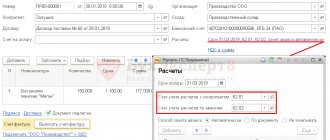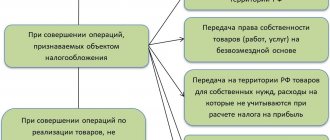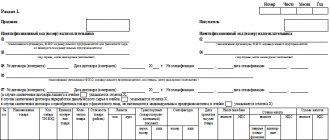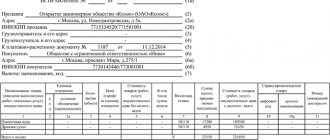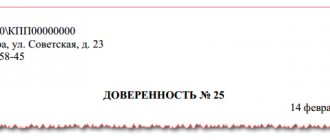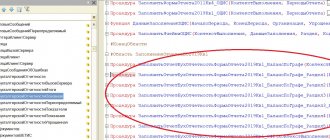The new form (form) of the invoice is valid from January 1, 2021. What has changed on the form? What does the fill sample look like now? How do VAT changes from 2021 affect invoices? When is an invoice issued in 2021 according to the new rules of the Tax Code of the Russian Federation? We will answer your questions.
Also see:
- VAT return form in 2021
- Review of VAT amendments from January 1, 2021
Invoice: when issued in 2021
As a general rule, an invoice must be issued no later than five calendar days from the date of shipment of goods, transfer of work, services, property rights (clause 3 of Article 168 of the Tax Code of the Russian Federation). For example, the goods were shipped on April 11, 2021. You can issue an invoice on any of the following five calendar days: April 11, 12, 13, 14, 15, 2021.
If the last day of the period falls on a weekend or non-working holiday, draw up an invoice no later than the next working day (Clause 7, Article 6.1 of the Tax Code of the Russian Federation).
Issue an advance invoice no later than five calendar days from the date of receipt of the advance payment (clause 3 of Article 168 of the Tax Code of the Russian Federation). For example, the advance payment was received on January 29, 2021. You can issue an invoice on any of the following days: January 29, January 30, January 31, February 1 or 2, 2021.
Invoice form 2019-2020: how the form has changed
Currently, the current version of the invoice form is valid from 08/19/2017.
The increase in the tax rate from 18 to 20% did not affect the invoice form, since the rate is not “hardwired” into the form, but is indicated when filling it out. Read more here.
Thus, now the following forms can be considered old-style invoices:
- until 07/01/2017 - as amended on 11/29/2014;
- from 07/01/2017 to 09/30/2017 - as amended on 05/25/2017.
Let us recall that the latest changes, which required adjustments to the invoice form of the old form, were caused by updating the list of mandatory details given in Art. 169 Tax Code of the Russian Federation:
- from 07/01/2017, an additional line appeared above the main table to indicate the data of the government contract (contract, agreement);
- from 10/01/2017, a new column “Product Type Code” was added to the main table, the name of the column “Customs Declaration Number” was changed by adding the definition “registration” to the word “number”; In the field reserved for signatures, an indication of the possibility of signing by an authorized person instead of an individual entrepreneur appeared.
But if the preparer does not need to enter the specified data into the document being drawn up, can he use the old invoice form when processing the shipment? What will be the consequences of accepting such a document for the recipient and is it possible to deduct VAT on old-style invoices? The answers to these questions follow from the significance that the invoice has among other documents used by the taxpayer.
Read about what has recently changed in the rules for registering purchase and sales books in the following articles:
- ;
- “What are the basic rules for filling out and maintaining a purchase book in 2021 - 2021?”
Sample of filling out an invoice in 2021
In order to correctly fill out the invoice in 2021, take the information from the primary shipping documents - invoices, acts. If there was an advance payment, payment details will be required for line 5 (Letter of the Ministry of Finance dated 02/06/2018 No. 03-07-14/6704).
You can fill out the invoice form in 2021 with a VAT rate of 20 percent:
The rules by which invoices must be filled out in 2021 are given in Government Decree No. 1137 dated December 26, 2011. These rules also did not change in any way in 2021 (this is logical, because the invoice form itself has not undergone amendments). At the same time, we recall that the Tax Code of the Russian Federation has established a number of mandatory requirements for the preparation of invoices. They are contained in clauses 5, 5.1, art. 169 of the Tax Code of the Russian Federation.
Here is the general approach and rules for filling out invoices in 2021:
- Fill in the lines about the consignor and consignee when shipping goods; put dashes in invoices for work or services. If the shipper is the seller, write “He” on line 3;
- The government contract identifier is needed only for shipments under government orders.
- a product type code is needed when exporting to the EAEU - select it from the HS reference book;
- Take the code and designation of the unit of measurement from Sect. 1 or 2 OKEYS, for example, “796” and “pcs”. If there is no price per unit in the contract or your units of measurement are not in these sections of OKEI, put dashes in columns 2, 2a, 3 and 4.
- the registration number of the customs declaration, the name and code of the country from OKSM is indicated by the importer of the goods. If you resell the goods, column 11 does not need to be filled in.
- number invoices in chronological order. However, violation of the numbering is not critical - it does not deprive the buyer of the right to deduction (Letter of the Ministry of Finance dated January 12, 2017 No. 03-07-09/411).
- The invoice is signed by the director and chief accountant or other employees authorized by order or power of attorney (clause 6 of article 169 of the Tax Code of the Russian Federation).
An invoice is a document on the basis of which the buyer can accept for deduction the amount of VAT presented by the seller of goods (works, services), property rights (clause 1 of Article 169 of the Tax Code of the Russian Federation). This is the main purpose of the invoice, so it plays a big role for VAT payers. Having received from the seller a correctly drawn up invoice, in which there are no errors that would prevent the tax authorities from accurately identifying the seller, the buyer, the name of the goods (work, services), their cost, the tax rate, the amount of tax charged to the buyer, the latter will have the right to accept the amount indicated in the invoice. invoice the amount of VAT to be deducted or include the tax in the cost of purchased goods, works, services (clause 2 of Article 169 of the Tax Code of the Russian Federation). Provided that there are also documents confirming their acceptance for registration, for example, a delivery note or an act (clause 1 of Article 172 of the Tax Code of the Russian Federation).
If the buyer receives an incorrect invoice from the seller, you have the right to ask the seller to make appropriate corrections.
Read also
04.04.2017
What's changing
Until January 1, 2021, electronic primary documents, UPD forms and invoices can be created in two formats:
- in the old one, which is enshrined in the order of the Federal Tax Service dated March 24, 2016 No. ММВ-7-15/ [email protected] (hereinafter referred to as order 155),
- and the new one, which was approved by order of the Federal Tax Service dated December 19, 2018 No. ММВ-7-15/ [email protected] (hereinafter referred to as order 820).
On January 1, 2021, Order 155 will no longer be in force; it will be possible to create invoices and UPD only in a new format. In the old format, they will not comply with the requirements of the law (clause 1 of Article 169 of the Tax Code of the Russian Federation).
The Federal Tax Service will accept documents in the old format that you submitted before January 1, 2020 until the end of 2022. In 2023, receiving complexes will no longer process electronic invoices and UPD with invoices in the old format. You will only be able to submit a printed form of the document.
New details in VAT documents
In order No. ED-7-26/736 dated October 12, 2020, the Federal Tax Service indicated that if a document on the buyer’s consent to a change in the cost of shipment is used to document the fact of a change in the financial condition of the transferring and receiving parties (or only the transferring party), the details of such consent (notification ) must also meet the requirements of the Federal Law of December 6, 2011 No. 402-FZ “On Accounting” - to the details of the primary accounting document.
In general, from November 27, 2020, in the new format of the adjustment invoice and the document on the buyer’s consent to change the cost of shipment, you can also indicate the following information:
- about the traceable product;
- labeling.
In addition, the Federal Tax Service introduced additional data about the product. This can be an article, grade, code, name of the unit of measurement and code of the type of product according to the commodity nomenclature of foreign economic activity (TN FEA).
Read also
10.07.2019
The procedure for applying new formats of VAT documents
We are talking about the order of the Federal Tax Service dated October 12, 2020 No. ED-7-26/736, which is valid from November 27, 2021. In order to improve electronic document management, he introduced new formats for sending:
- adjustment invoice;
- a document confirming the consent (fact of notification) of the buyer to change the cost of shipped goods (work performed, services rendered, transferred property rights), which includes an adjustment invoice;
- the same document without the adjustment invoice.
At the same time, a similar order of the Federal Tax Service dated April 13, 2016 No. ММВ-7-15/189 is lost. Note that he did not include the third format from the list.
Please note that the Federal Tax Service has established a transition period . So:
- from November 27, 2020 to October 1, 2021, you can create (generate) electronic adjustment invoices in both formats - old and new;
- from November 27, 2020 to January 1, 2025, tax authorities are required to accept adjustment VAT invoices created in electronic form before October 1, 2021 in the old format approved by Order of the Federal Tax Service dated April 13, 2016 No. ММВ-7-15/189.
How will the invoice change from October 1, 2021?
An invoice issued by the seller is a document according to which the buyer can deduct the VAT charged to him (Article 169 of the Tax Code of the Russian Federation). As a rule, invoices are issued in “paper” form, but, with the consent of the buyer, the seller can fill them out electronically.
The next changes to the current form and rules for filling out invoices were made by Decree of the Government of the Russian Federation dated August 19, 2017 No. 981. What the new invoice form will look like from October 1, 2021 can be seen at the end of the article, and the main changes are as follows:
- Added on July 1, 2017, line “8” about the identifier of the government contract/agreement was brought into compliance with the Rules for filling out invoices and supplemented with the words “if available.”
- From October 1, a separate column “1a” of the invoice contains a code for the type of goods according to the unified Commodity Nomenclature of the EAEU. It is indicated by those who are engaged in export, exporting goods from Russia to the countries of the EAEU (Belarus, Kazakhstan, Kyrgyzstan, Armenia). Previously, the code could be entered in one column with the name of the product. A similar addition has been made to the adjustment invoice form - column “1b” has been added for the product type code.
- The name of column 11 has been clarified - now the word “registration” has been added to it, which clarifies which customs declaration number we are talking about. According to the order of the State Customs Committee of the Russian Federation No. 543 and the Federal Tax Service of the Russian Federation No. BG-3-11/240 dated June 23, 2000, the registration number of the customs declaration is assigned when it is accepted by an official of the customs authority - it is this, and not the serial number, that should be entered in column 11 of the invoice - invoices for goods of non-Russian origin.
- For individual entrepreneurs, the wording of the line intended for signature has been clarified - now it reads “Individual entrepreneur or other authorized person.” Let us remind you that persons who have a notarized power of attorney can sign an invoice for an individual entrepreneur.
Technical side of the issue
The structure and format of the field “Registration number of the customs declaration” in the electronic document has not been subject to any changes since 10/01/2017. It allows you to enter from 1 to 29 characters. Thus, the electronic invoice format allows for a DT number in either four or three parts.
In Diadoc in printed form, which, we recall, is not a legally significant document, the name of column 11, in accordance with the new edition of Resolution No. 1137, will be changed to “Registration number of the customs declaration.” It will reflect the value that was entered when generating the electronic invoice.
Will buyers have problems accepting deductions on old invoices?
The situation is not as clear-cut as it might seem. On the one hand, an invalid invoice form cannot be used. On the other hand, the Tax Code of the Russian Federation clearly and comprehensively establishes the grounds on which a VAT deduction cannot be accepted: this is the absence in the document of the details listed in paragraphs. 5, 5.1 and 6 art. 169 of the Tax Code of the Russian Federation. At the same time, paragraph 2 of Art. 169 of the Tax Code of the Russian Federation does not pose any obstacles to accepting a deduction on an invoice that contains minor defects that do not interfere with the identification of:
- seller;
- buyer;
- name and cost of goods (work, services) supplied;
- amount and VAT rate.
This norm appeared in the Tax Code of the Russian Federation as a reflection of the position of the Constitutional Court of the Russian Federation (determination dated February 15, 2005 No. 93-O). The court clarified that the Tax Code of the Russian Federation does not prohibit the deduction of VAT if the tax authority is provided with all the necessary information and documents for conducting tax control.
Thus, if the lack of information provided for in the new columns and lines of the invoice does not prevent the identification of the information listed above, there is hope that the tax authorities will not refuse a deduction on the old forms. But, of course, it is better not to tempt fate and get the correct document from the supplier.
For information about which errors in filling out an invoice the Federal Tax Service considers non-critical for VAT deduction, see here.
Time will tell whether they consider the non-filling in (or incorrect formatting) of the added details of the new form critical.
